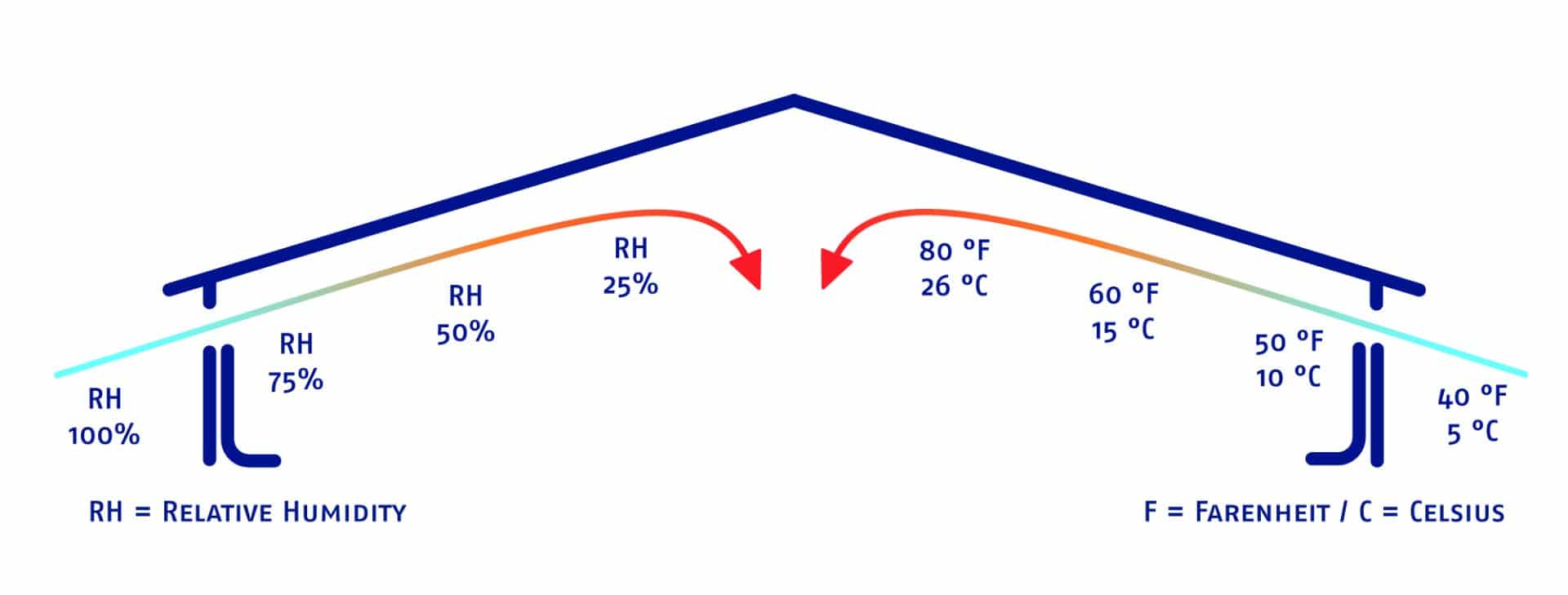Combining ventilation concepts for very large poultry houses
In this white paper, we discuss how ventilation can be organized in very large poultry houses. There is a trend going in which poultry houses become wider and longer. Increasing the size of a poultry house benefits production capacity but also requires a more specialized ventilation concept. With the increased dimensions, using only one concept all year round will not be enough. A combination of different techniques optimizes the indoor climate and overall flock performance.
Small screen? PDF version available here
Table of contents
– Introduction
– The challenges that come with ventilation in very large houses
– How different ventilation techniques can work together for optimal performance
– Aspects of ventilation and climate unique to large houses
– Conclusion
Introduction
As the world changes, ventilation changes with it. Over the years, poultry houses have increased in size. However, this has caused challenges in the industry. With increased width, the building requires structural supports that can sometimes block interior equipment. For ventilation and the guidance of airflows through the building, the increased width makes the ventilation concepts more complex. To ensure an optimal and stable climate, all year round, ventilation should be taken into account from the very start of designing the house.
The challenges that come with ventilation in very large houses.
The following details describe the increase in dimensions of poultry houses in the US; Houses built during the 1980s were typically about 16,000 square feet (400 feet long by 40 feet wide). The industry standard grew to 20,000 square feet (500 by 40) by 2000. Houses built in 2007-2011 averaged over 23,000 square feet. Many retained the 500-foot length but were 50 to 60 feet wide (15 to 18m), while the largest new houses were nearly 40,000 square feet (600 by 66ft or 180 by 20m). Source: USDA.GOV / National Agricultural Statistics Service / ERS. This source tells us that the width of houses around 2011 had become typically around 60ft or 20m. The width and size of houses have continued to grow over the last ten years. Nowadays, we often see houses of around 78ft / 24m wide and occasionally even wider. With the appearance of multistory poultry buildings in Asia, one can tell that upscaling is not slowing down.
Upscaling
Increasing farm size has always been a strategy for raising production capacity and profits. In the Chinese pig and poultry sector, we now see multistory buildings to answer production needs. Often with integrated manure processing facilities and slaughterhouses. On the other hand, when land is cheap and plentiful, similar upscaling happens with multiple large poultry houses built side by side.
Maximum and minimum ventilation
When the birds get heavier, or in the summertime when it is very warm, ventilation is running at maximum capacity.
Tunnel ventilation is often a good solution to move large volumes of air through the house. Not only does tunneling
work well to provide fresh air and remove exhaust gasses, it also provides a wind-chill effect to alleviate heat stress.
Getting minimum ventilation right is more challenging.
In particular when the birds are very young or during wintertime. During these sensitive ventilation stages, getting
the air to reach all the animals proves much more difficult. Especially when poultry houses are 78ft / 24m in width, or
sometimes even wider. With a large house, the real challenge is getting the air up to speed to reach the center.
Reaching the center of the house
With air inlets in the correct position, fresh air is guided upwards along with the ceiling. The Coanda effect then
helps the air stick to the ceiling to gain extra distance. While warming up and traveling to the center of the
house the relative humidity decreases. The warm air then reaches the animals, dries the litter and soaks up dirty
gasses before leaving the house.
If the air does not reach the center of the house, it cannot warm up properly. When this happens, the air stays humid
and trouble is to be expected. It can come in many forms, like wet litter, thus laesions on the birds’ feet. Or respiratory
problems, when there is not enough capacity to soak up gasses like hydrogen sulfide and ammonia.
 Obstructions in the house
Obstructions in the house
It can be hard to get the air where it needs to be when layer nests and other obstacles are blocking the way. When houses are over or around 78ft / 24 meters in width, they often have support structures, as seen in
the picture on the left. The beams under the ceiling are particularly disruptive to the airflow. For air inlets, an air guide can be the perfect solution to direct air underneath support beams. In addition, ventilation chimneys bring in fresh air from above, guiding it into the corridors, which are otherwise hard to reach. Diffuser plates mounted under the chimney prevent cold air from dropping directly onto the animals. Chimneys and ceiling inlets are easily the most effective method for delivering air in between layer nests. In large poultry houses, having different ventilation methods is the best practice. Combining wall inlets with chimneys is a well-known and effective ventilation method. The combination also makes sure that fresh air reaches all corners and crannies of the house. Add tunnel ventilation to the mix, and the system is ready for all types of weather.
How different ventilation techniques can work together for optimal performance:
- Wall inlets help to direct incoming air towards the ceiling. The Coanda effect then causes the air to “stick” and follow the ceiling up towards the center of the house. Concentrating the air into a bundle also helps increase airspeed, allowing air to be thrown further into the house.
- Ceiling inlets are a perfect solution for wide houses. Because they are installed in the ceiling, these inlets can be situated wherever they are needed. When there is no ceiling, a central air corridor is often constructed at the ridgeline, distributing air from the ridge point downwards into the house. These inlets bring fresh air in from the attic, where it first has time to reach comfortable temperatures.
- Chimneys are often used for air exhaust, but they can also offer the perfect solutions for air intake. In wide houses, intake chimneys can bring air directly to every desirable spot. Intake chimneys are equipped with diffuser plates to stop air from falling directly onto the animals. Instead, they disperse air parabolically from the top down, so that the air can never flow horizontally into nesting systems.
- Circulation fans can help spread the air through the house but also will disturb the airflow in general. Their effects on the air pattern inside the house should be measured with smoke tests. The positioning of ventilation equipment isn’t in most cases a guiding principle when building or designing a new house. Traditionally, ventilation systems come as a second or third step in the equipment selection process. When you do take the ventilation system into account from the start, you have a huge advantage. With little effort, you can position your ventilation equipment in the exact right place and ensure an optimal indoor climate. Keeping this climate stable all year round is the next challenge. When everything is set up just right, the benefits of a healthy flock become clear. In the end, good climate results in better animal performance, higher production numbers, increased profit, energy cost reduction, and, therefore, peace of mind!
Aspects of ventilation and climate unique to large houses
When comparing smaller houses to the larger ones, a few aspects need extra attention. With increased size comes an increased number of birds, therefore, making sure the right methods of ventilation are used is critical. When there are more animals, there are also more exhaust gasses, these will typically stay close to floor level and need to be taken out of the house. In large layer houses with multiple rows and tiers of systems, good ventilation from the top down is required.
When combining ventilation techniques, having the right computer to control the systems is key. In houses working with a negative pressure system, the control is managed from the exhaust end of the building. In equal pressure systems, the system is controlled from both the intake and exhaust end. Therefore, these houses need more sensors and should be equipped with more refined control. Think of controlling the dampers of intake chimneys individually instead of setting up groups. This does require accurate measurements for the different sections of the house. Data is king, so good measurements combined with a variety of ventilation components result in optimal control.
In conclusion
The widest of poultry houses are often best ventilated through a combination of methods. The positioning of wall inlets is imperative for creating an airflow that sticks to the ceiling and reaches the center of the house. The key feature for wall inlets is the shape of the inner valve. The inner valve, if designed correctly, helps bundle the air to bring it as far into the house as possible. Higher negative pressures also help to improve airflow and stability.
Guiding air into the house from the top down is the easiest way to make sure fresh air reaches all corners and crannies in the house. Ventilation chimneys or ceiling inlets are therefore a perfect solution for layer houses with nesting systems. At the maximum ventilation range, tunnel ventilation is often the best solution.
In very large houses, having just one ventilation technique to control the climate year-round is not sufficient. A combination of techniques is needed to work together and help transition from minimum to maximum ventilation and back. Complex ventilation concepts require specialized computers and more measurements to work well. With optimal climate comes optimal production, so taking the ventilation concept in mind while designing the house is very much of the essence.
Sources:
United States Department of Agriculture
“Combining ventilation concepts for very large poultry houses”
By; S.M.H. Jacobs, Marketing Coordinator at TPI-Polytechnics
Den Bosch, 01-10-2021




 Obstructions in the house
Obstructions in the house
